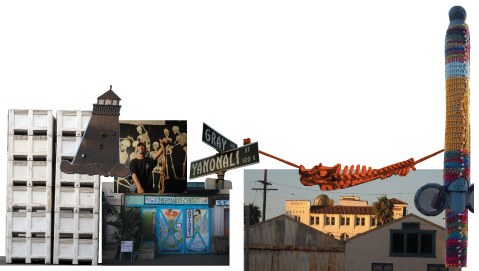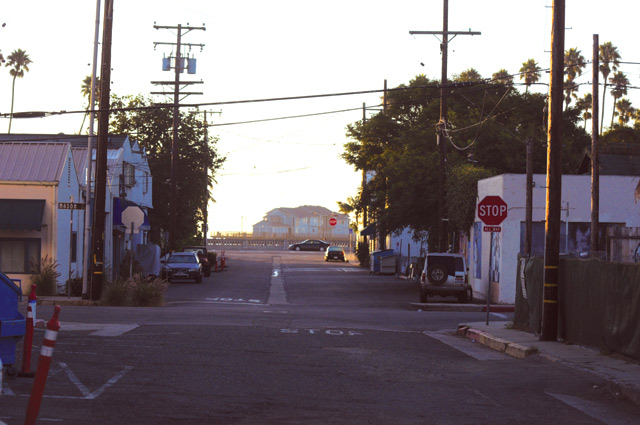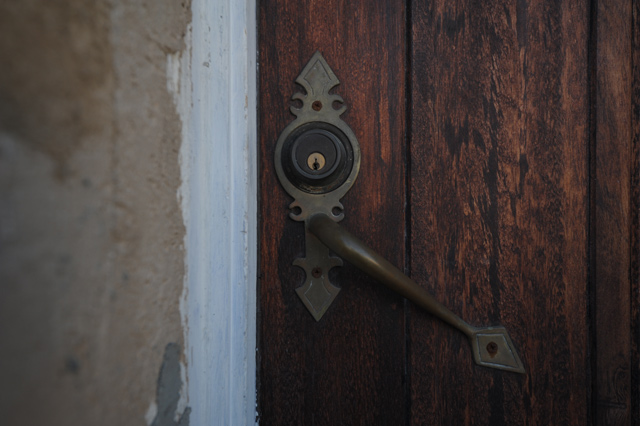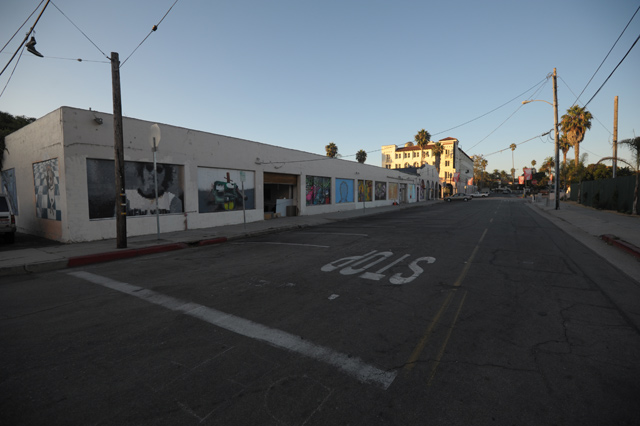
Photos by Paul Wellman
Take a stroll through the Funk Zone, and immediately it becomes clear this is not the Santa Barbara of postcard fame. Within the same distance as two holes on a golf course, you can encounter a strip club, a bustling gym, a few auto-body repair shops, Santa Barbara’s Farmers Market headquarters, a mysto high-end classic-car showroom, a variety of wineries, dilapidated old warehouses, a Segway rental spot, a seafood market, surf shops, a splattering of restaurants, a couple bars, untold art studios and illegal living spaces, and one vintage fire-engine-red phone booth that doesn’t work but is always on the move. Juxtapose this with the rest of Santa Barbara, and, well, you cannot help but scratch your head and ask, “What the hell?”
The Funk Zone was “funky” and functional long before the nickname was ever coined. In the mid 1900s and earlier, what we now call the Funk Zone was the industrial, marine, and manufacturing part of town. The Lockheed Corporation was born there, one of Santa Barbara’s first grain mills and feed stores was there (memorialized to this day by the tall, monolithic building at the ocean end of Gray Avenue), the Castagnolas used the area as ground zero for their fishing empire, and Radon Boats rose to prominence on Funk Zone soil, to name a few.

As Santa Barbara got spit-shined by development and redevelopment efforts, this hard-working part of town just sort of slipped through the cracks. However, as the 1980s came to a close, the “potential” of the waterfront region east of State Street became too much for real estate–minded folks to ignore.
All signs point to the mid ’90s as being the time when the term “Funk Zone” started gaining popularity. As the story goes, with development pressure in other parts of town driving up rent and forcing artists and craftspeople out, a public movement, led in part by former arts commissioner Patrick Davis, got underway to get the city to stick up for the arts via language-specific zoning rules. During this protracted process, walking tours were taken by planning commissioners, members of the City Council, and arts advocates to find just the right place for such a designation. While discussing the area south of the freeway and east of State Street to Santa Barbara Street, the word “funky” was repeatedly used by several people to describe the menagerie of land uses in the area. According to several sources, Don Olson, then a senior city planning official, proposed that should such an art-friendly zoning regulation be applied to this area, it could be called “The Funk Zone.” True or not, the nickname stuck.

The efforts of Davis and Olson — and many others — took on even more importance when, as 2000 approached, a variety of large-scale, luxurious development projects in and around the Funk Zone were chugging toward final approval. The city, working to get its land-use codes in step with the California Coastal Act, took the opportunity to explore different types of rezones in the Funk Zone region that would help preserve some of the neighborhood’s charm in the face of the onslaught of high-end condos, hotels, and a proposed aquarium (think Bill Levy’s La Entrada and Jim Wright’s Garden Street dream) while also satisfying the desires of its own redevelopment agency. Controversial to this day, the city’s decision was ultimately to adopt a code that requires things in the Funk Zone to either be tourist-serving in nature, mixed-use residential/commercial units, or marine-oriented light manufacturing. In short, everything in the Funk Zone will eventually fall into one of these categories.

“Unfortunately, the formula is there to make [the Funk Zone] disappear, or at least change in a pretty big way,” said Santa Barbara City Planner Bettie Weiss of the not-so-new zoning rules. And whether her observation is music to your ears or the latest reason for you to leave town, it cannot come as much of a surprise. After all, in a city that seems increasingly committed to homogenization, tourism dollars, and “smart” planning, an area with such cherry development potential is undoubtedly an endangered species.
Yet formulas don’t always work the way they should. As Paul Casey, assistant city administrator and Redevelopment Agency deputy director, put it recently, “We had a lot of development plans coming forward that put pressure on [the Funk Zone] but, as it turned out, none of which really came to pass.”

In the wake of those failures, the Funk Zone has been able to not just survive but evolve in such a way that it will quite possibly remain vital and vibrant even if those building plans get realized in the years ahead. The exploding wine scene and the success of food-serving libation spots like Reds and Union Ale, alongside the organized efforts of Funk Zone guardians of the arts like the folks from Fishbon, the Arts Fund Gallery, and the Artists Making a Street Scene (AMASS), have created a strong-enough buzz to complement the still-established (though admittedly reduced) blue-collar ethic of the neighborhood that it will be difficult for any future developments, no matter how high-priced in nature, to destroy it completely.
In fact, the biggest mover and shaker in the Funk Zone of late, Central Coast Real Estate (which works on behalf of businessman Brian Kelly), says it’s the neighborhood’s more quirky and artsy charms that first got the company interested in its most recent purchases — three lower State Street parcels —and have them kicking the tires on at least two other buildings in the area. “We want to keep the funk in the Funk Zone,” explained Central Coast’s Katie Hay. “It has a unique culture all its own and we want to keep it that way.”



